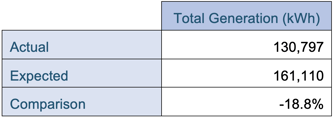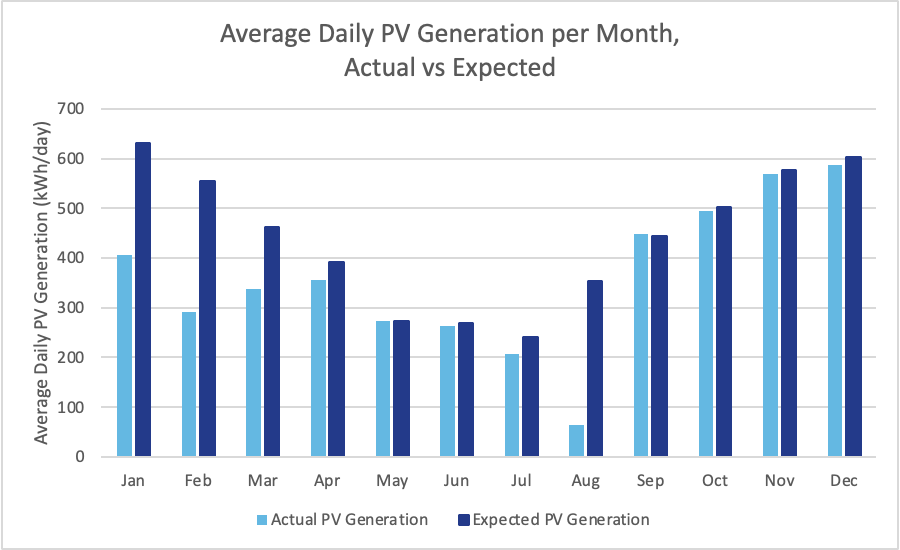Last week we reviewed a case study which showed how a PV system installed, monitored, and serviced correctly can outperform expectation, even years after it was installed (check out last weeks blog post here). This week we take a look at the opposite and explore how system and inverter downtime can severely impact system performance if regular monitoring and maintenance is not in place.
A Western Australian abattoir installed a 99 kWdc solar PV system at their plant at the start of 2019 to supply electricity to the site. The system is a ground-mounted, 20-degree fixed-tilt system with 300x 330W Trina panels and 3x 27 kVA Fronius ECO inverters.
Beam Energy Labs were engaged to review the performance of the system and provide recommendations to improve performance if necessary. To review existing performance, actual solar generation data was provided by the WA plant for the period Jan 2021 to Dec 2021. This was compared to Solcast® solar irradiance data for this location over the same timescale. The Solcast® solar irradiance data was converted to expected PV generation data using appropriate loss factors for each timestamp.
Performance
Throughout 2021 the system showed substantial underperformance when looking at annual generation compared with the expected values. The impact of inverter and system downtime played into this underperformance. The table below shows that the system underperformed by approx. 18.8% during 2021 when compared to the expected generation.

The comparison in monthly generation data below shows that the system performed particularly poorly from January to March, and worst of all in August.

Upon review of the data, it was found that a single inverter outage from January through to early April contributed to the underperformance at the start of the year. This is shown by the graph below which compares the real and expected PV generation over a 3-day window in January 2021.

In addition, several full system outages throughout the year also contributed to the underperformance. These outages occurred during the following days:
- 19th – 24th Feb,
- 18th – 19th Apr,
- 30th Jul – 27th Aug.
The last outage was the longest period of system downtime and was the cause for the severe underperformance during August.
Inverter size and clipping
A review of solar production on the two largest generation days over the dataset, 29th November 2021, and 5th December 2021, did show some evidence of clipping. The chart below shows solar output for both days. Clipping is observed for a short period during the peak solar period and solar production reaches the 81 kW inverter limit.

Upon further review of the expected generation data, the impact of clipping on this system attributed to a reduction in generation of ~1.1% per year.
Conclusion
From the review of available data, we can conclude that several full system outages, and an unchecked inverter outage early in the year, contributed to a substantial underperformance for this system. Had regular system monitoring and maintenance been in place, these issues would have been identified and rectified much quicker, and the impact on annual system performance would have been substantially less.
To ensure that your system is always monitored for any issues, we strongly recommend engaging in an ongoing service agreement with Beam Solar, or your solar installer. This way, you can minimise the impact of downtime and guarantee that your system will continue to meet expected generation and savings figures throughout its life. Service agreements can include many different options and can be bespoke to your specific business needs. Reach out to anyone in the Beam Solar team and we would be happy to discuss service agreements in more detail.
About Beam Solar
At Beam Solar we aim to assist our customers in making the best business decisions for their solar investment projects. That includes providing guidance not only through the early stages of the project (feasibility, energy assessments, and quoting), but also through procurement and ongoing service.
In order to ensure you get the most out of your new solar system, we will complete a post-install system inspection to identify any defects with the system and arrange for rectification. We can also provide a performance and savings assessment on the system several months after install to confirm if the system is performing as expected. This is to provide additional trust and ensure that your system is providing the maximum benefit to you and your business.
If you are wondering what solar can do for your sites, start a Beam Solar assessment by clicking the button below.
